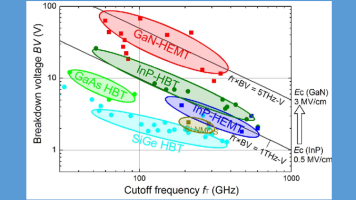GaN technology is seen as a disruptive technology for space applications due to its superior performances. For RF applications, the benefit for space is tremendous as solid-state GaN transistors allow replacement of bulky TWT amplifiers for high output power applications ranging from P-band to Ka-band. The ability to realize compact SSPAs is an enabler for space based active phased array antenna systems, since this novel technology allows increased integration and wider operating bandwidths. However, RF industrial GaN HEMTs are currently qualified only up to Ka band (30 GHz) using a gate length of 150 nm. Future Telecommunication and Earth Observation applications will require high performance GaN based SSPAs to also be available in Q, V and W-band frequencies. Nevertheless, further reducing the gate length to reach higher frequency requires a complete change of the fundamental epitaxial materials and device design.
Breakthrough technologies are needed to achieve simultaneously high efficiency and linearity under high output power, together with high reliability and mastering of space compatibility aspects at such frequencies. So far, none of the concepts proposed worldwide give the complete picture that would allow a space qualified mmW GaN technology to be realized.
The proposed work aims to assess and quantify performances of new materials and device topologies of mmW GaN-based transistors allowing frequency extension up to W-band with the aim of achieving new stretch targets. The novelty lies on an extensive survey of advanced concepts studied worldwide with respect to the whole figure of merits while including theoretical investigations of the most promising concepts based on TCAD SILVACO simulations and checking the manufacturability of each approach with main EU epi-suppliers.
The outputs from this study will allow ESA to focus its future GaN process development efforts to help enable a European supply chain for state of art mmW GaN MMIC technology.

